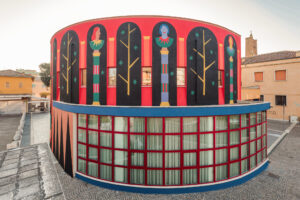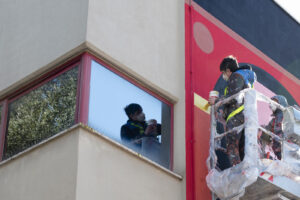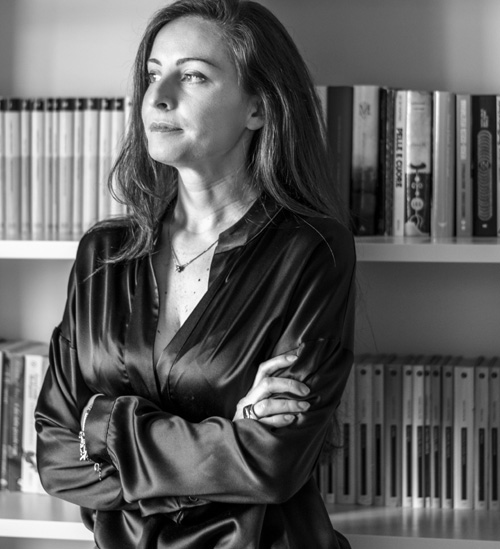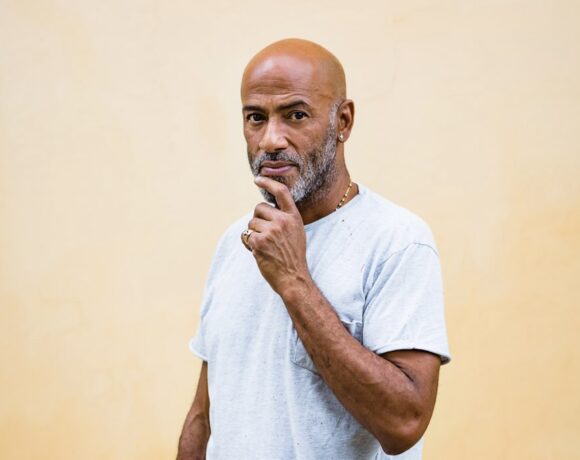In 1948, the American art critic Clement Greenberg published an essay in which he analyzed art practices from Impressionism to Abstract Expressionism, focusing on the work of Jackson Pollock, whose compositions are originated from a tight mesh of repeated gestures on a canvas unrolled on the ground. In the essay, Greenberg stated how “the future of easel painting as an ambitious art vehicle has become problematic,“[1] summarizing in just a few words the transition away from easel painting, which was slowly being replaced by “allover” painting: off-centered and polyphonic, capable of revealing the impermeability of the surface and allowing the viewer to enjoy the work as if this was an observable fact. Confronted with such vision, in which painting abandons its normal representative methods, one of the greatest exponents of Mexican muralism, David Alfaro Siqueiros, in 1924 shouted his opinion to the community in his manifesto: “we repudiate the so-called easel painting […] we praise monumental art in all its forms, because it is of public utility.”[2]
The essence of the above historical passages can be taken into consideration in light of the project Sol Indiges, organized by the Comune of Pomezia in collaboration with the Fondazione Pastificio Cerere and curated by Marcello Smarrelli with artists Agostino Iacurci (1986, Foggia) and Ivan Tresoldi (1981, Milan), aka ivan.
About the reason why these artists were chosen, the curator said “they are among the most interesting personalities in the field and they have demonstrated it through numerous particularly significant public artistic interventions in different parts of the world.” Sol Indiges is an urban requalification plan based on the artistic practice of murals and involves three buildings in Pomezia: the Ugo Tognazzi Municipal Library for Agostino Iacurci, inaugurated on April 9th, and the Orazio and Publio Virgilio Marone schools, whose murals will be developed by ivan in October 2021.
Pomezia is a young city, arisen from the marshy lands of the Roman Agro Pontino that were reclaimed around the thirties of the twentieth century and that began to take shape with a land-use plan by Rationalist architects. However, an ancient shadow looms over the city: in the Virgil’s Aeneid, Sol Indiges is the name of the sanctuary dedicated to the Sun God, built where Aeneas landed at the mouth of the Numico River, located in the countryside surrounding the city. The project curated by Marcello Smarrelli captures all these references and honors the history of the territory and the literature dear to the national identity. Smarrelli clearly explains it with: “the starting point is Aeneas and the foundation of Rome through Virgil’s narration. But we also want to underline the importance that the Aeneid had in the genesis of the Divina Commedia in this 700th anniversary of the death of Dante.”
The urban requalification experience curated by Smarrelli crystallized on the architectural places devoted to the safeguard of the city’s cultural values. Thus, the works by Iacurci and ivan present themselves as part of the identity of a social capital aimed at enlivening the transmission of cognitive and intellectual resources of an entire community. Smarrelli clarifies how: “thanks to the use of an immediate and engaging language, Iacurci and ivan’s works communicate in a transversal way, directly reaching different and heterogeneous audiences. But like any artistic intervention for the public space, these actions must necessarily move according to the dialogue between authors, citizens, institutions, and clients, in order to become a shared cultural asset and identity.“
The mural work by Agostino Iacurci is entitled Antiporta and it evolves on the surface of the Tognazzi public library with iconographic references to the book VI of the Aeneid – where, in a cavern with a hundred doors, Aeneas met the Cumaean Sibyl who predicted the hero’s landing on the coasts of Latium. The artistic fertility of Iacurci designed a mural work arranged according to a figurative schematism based on geometric signs and complex iconographic references. The golden branches, the figures of the handmaids and the profiles of the Roman ancient naves are all reinterpreted historical elements. The distance helps the overall visibility of the work, the two-dimensional flatness stimulates us to imagine the figures’ volumes, so what we hieratically see is nothing but an invitation to picture the characters as if moved by a rhythm.
This interpretive richness stems from Iacurci’s relationship with the literature, to which he has “related very freely. It’s always interesting to reread a classic text in its entirety with new eyes. Usually, classics are known only in the form of paraphrases and pills from school.” It is Iacurci himself who claims to have built his idea “on the magical aspects of the poem and the theme of the journey,” using, as a secondary support to the Virgilian opera, the volume “Aeneas, the stranger: the origins of Rome” by Giulio Guidorizzo (2020). Presenting his work as contemporary pictography, the images that emerge on the architectural structure evolve according to a compositional balance dear to classical painting, especially Hellenic, so that Iacurci’s figures are revealed by the exogenous, epithelial character marked by the manipulation of prismatic and cylindrical forms, from which the modules that suggest us a basic intuition originate. It is a perceptive abundance that pushes us to see things according to a perspective marked by the naïve style’s expressive purity. In Greenberg’s previously quoted excerpt, Crisis of Easel Painting, the American critic coined a series of terms used to describe post-war American painting. It would not seem reckless to use these same terms for Iacurci’s decoration: colorfield, intended to be a work that expands beyond the classical level of easel painting and allover, inspired by uniform geometric rules based on two-dimensionality and frontality.
Looking at Iacurci’s past exhibitions, his relationship with the antique is essential. He affirms that this research started after he visited the exhibition “Gods in colors” in Mexico City, which “presented the results of years of research of the archaeologist Vinzenz Brinkmann” through full-scale reconstructions of ancient Greek and Roman statues according to the original colors. Could this awareness have influenced Iacurci’s use of color? It seems so, considering how much such a discovery made the artist reflect “on the power and the implications of some data that we take for granted, such as the whiteness of ancient statuary, with all the political and cultural implications that derive from it” until it led him to a deeper dive into the “classics such as Vitruvius and Virgil.”
Regarding the second intervention that will be developed in the fall of 2021, the artist ivan wants to clarify that it will be “a work of public and participatory art that embraces all the dimensions of sociality and culture, where the same work is amplified and strengthened. A work that makes a performance out of dialectic, happening, neo-muralism, shared knowledge, urban design and regeneration, street poetry and poetic assault.” With the intent of creating shared value for the community, the title of the mural is self-explanatory: “Call To The Arts-Making School.” A mural work, born of the desire to “yield” to the territory through mural practice, which ivan defines as “a monologue on poetry and the value of words” to be presented as a “new social ecology which fosters positive processes of solidarity between the participants and the surroundings“. The explicit situation poses itself, therefore, as a very interesting question for contemporary art. It raises the question of whether there is a specificity of its own, a sort of surplus value, or, on the contrary, that spaces reveal themselves when given a purpose. The most logical answer lies in the artistic tool as such and in the surplus value that characterizes it!
Maria Vittoria Pinotti
[1] Clement Greenberg, La crisi della pittura di cavalletto (1948), in Il luogo dell’arte oggi, Jaca Book, Milan, 1988, p.134
[2] Hal Foster, Rosalind Krauss, Il muralismo messicano, in Arte dal Novecento, Zanichelli, Milan, 2017, p.280
 Agostino Iacurci, L’antiporta, 2021, area involved in the project about 1000 square meters, Ugo Tognazzi Municipal Library, Pomezia, Ph. Credit Andrea Pizzalis, Courtesy Fondazione Pastificio Cerere
Agostino Iacurci, L’antiporta, 2021, area involved in the project about 1000 square meters, Ugo Tognazzi Municipal Library, Pomezia, Ph. Credit Andrea Pizzalis, Courtesy Fondazione Pastificio Cerere
 Agostino Iacurci, L’antiporta, 2021, area involved in the project about 1000 square meters, Ugo Tognazzi Municipal Library, Pomezia, Ph. Credit Andrea Pizzalis, Courtesy Fondazione Pastificio Cerere
Agostino Iacurci, L’antiporta, 2021, area involved in the project about 1000 square meters, Ugo Tognazzi Municipal Library, Pomezia, Ph. Credit Andrea Pizzalis, Courtesy Fondazione Pastificio Cerere
 Agostino Iacurci, L’antiporta, 2021, area involved in the project about 1000 square meters, Ugo Tognazzi Municipal Library, Pomezia, Ph. Credit Andrea Pizzalis, Courtesy Fondazione Pastificio Cerere
Agostino Iacurci, L’antiporta, 2021, area involved in the project about 1000 square meters, Ugo Tognazzi Municipal Library, Pomezia, Ph. Credit Andrea Pizzalis, Courtesy Fondazione Pastificio Cerere
 Agostino Iacurci, L’antiporta, 2021, area involved in the project about 1000 square meters, Ugo Tognazzi Municipal Library, Pomezia, Ph. Credit Andrea Pizzalis, Courtesy Fondazione Pastificio Cerere
Agostino Iacurci, L’antiporta, 2021, area involved in the project about 1000 square meters, Ugo Tognazzi Municipal Library, Pomezia, Ph. Credit Andrea Pizzalis, Courtesy Fondazione Pastificio Cerere
 Agostino Iacurci at work, Ph. Credit Riccardo Roberti, Courtesy Fondazione Pastificio Cerere
Agostino Iacurci at work, Ph. Credit Riccardo Roberti, Courtesy Fondazione Pastificio Cerere
 ivan, The page and the great hidden poetry, performance, Milan, 2016
ivan, The page and the great hidden poetry, performance, Milan, 2016

Maria Vittoria Pinotti (1986, San Benedetto del Tronto) is an art historian, author, and independent critic. She currently is the coordinator of Claudio Abate’s photographic archive and Manager at Elena Bellantoni’s Studio. From 2016 to 2023 she was the Gallery Manager in a gallery in the historic center of Rome. She has worked with ministerial offices such as the General Secretariat of the Ministry of Culture and the Central State Archive. Currently, she collaborates with cultural sector magazines, focusing on in-depth thematic studies dedicated to modern and contemporary art.






NO COMMENT